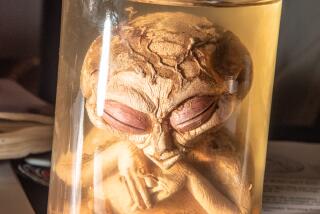Audiosphere: The ‘Wild Thing’ podcast is like ‘Serial’ for Sasquatches
- Share via
For more than a year, Laura Krantz searched for Sasquatches and the people who love them. She tromped through the Pacific Northwest looking for Bigfoot nests, frequented Sasquatch-enthusiast chat rooms, and talked to scientists about how DNA testing may be able to be used to help prove — or at least explain — the hairy fella’s existence.
Krantz’s new podcast, “Wild Thing,” a nine-part series whose first episode launches today, combines on-the-forest-floor reporting with eyewitness accounts and expert testimony on the theories behind the famous, hairy biped. But “Wild Thing” isn’t just the story of her search for one of the world’s favorite mysterious creatures, it’s a look into something just as surprising: her family history.
Krantz is Bigfoot royalty.
A paranormal pioneer
For Krantz, it all started in 2006, when she was reading a Washington Post article about a seemingly eccentric man by the name of Grover Krantz. Skeptical yet intrigued by a possible familial relation, she pursued the connection and discovered that the esteemed anthropology professor — widely regarded as a pioneer of Bigfoot research — was her grandfather’s cousin. He was also one of the first scientists to advocate for the creature’s existence, says Krantz.
Soon, she began spotting references to Grover online and in articles, and another name began popping up with unrelenting frequency as well: Bigfoot.
“He just kept reappearing sort of in my peripheral view,” she said. “Once you start thinking about Bigfoot, Bigfoot is everywhere.”
Following a few more twists of fate — such as finding out her home in Denver was only about 30 miles from the late Grover’s widow — Krantz decided to combine her unique personal connection to Bigfoot’s timeless lore by launching a podcast on the topic. Using her experience as a veteran radio producer — she was once the editor of a public radio show on L.A. station KPCC — she creates a visceral audio narrative based on rather rare access to some of the most seasoned experts and secretive locations associated with Bigfoot.
All thanks to the legacy of Grover, who is a big deal for Bigfoot fans.
Her family ties to Grover, Krantz says, helped ease her entrance into a community of Bigfoot believers that is often wary of outsiders. “I think saying I was related to him definitely opened doors that might not have opened otherwise,” she said.
The science of Sasquatch
Krantz, a self-identified skeptic, says she approached the story from a scientific standpoint like Grover would. For instance, she opted not to talk to people who thought Bigfoot was brought to Earth by aliens or had the ability to move through different dimensions of space and time. Instead, she delves into topics such as evolution, e.g. where Bigfoot would fit on the tree of life. Ultimately, it was the steady stream of wildlife biologists and seasoned outdoorsmen recounting their own Bigfoot sightings that moved the believability needle for Krantz.
“I kind of expected a lot of the “Oh-I-saw-Bigfoot” stories to be hard to swallow, and they ended up being one of the most compelling things for me to hear,” she said.
In the first episode of “Wild Thing,” Krantz not only sets the course for the rest of the series, but addresses some quick-hit trivia such as: What does Bigfoot prefer to eat? Fruit-filled pastries, apparently. Also, can there be a lady Bigfoot? Yes, according to the podcast.
To better answer where they may sleep, Krantz visits a secret location on Washington’s Olympic Peninsula. Two-and-a-half miles behind a locked gate, there appears to be a collection of large nests that her guides say were made by Bigfoot.
“This is … this … this is crazy,” says a bewildered Krantz in a field recording as she traipses through the forest.
Krantz gained access to this highly off-limits location with the help of Shane Corson, a longtime Bigfoot believer (who had his own sighting while on a fishing trip in 2011) and one of only two people with a key to the area’s gate. Corson is the co-runner of the Olympic Project, a group of researchers who explore the science behind the Sasquatch by employing methodical data collection. For example, in an attempt to identify the source of the large, bird-like ground nests Krantz visited, the Olympic Project has collected and cataloged hair samples found on site.
After thorough examination, some of these hairs have been connected to known animals in the area, said Corson; but many others have not. “Something is making these nests,” he says . “And it’s undocumented and it’s unknown.”
Beyond Bigfoot
Krantz also delved into the public fascination with Bigfoot.
The nine central story episodes of “Wild Thing” will be supplemented with intermittent bonus installments, which include in-depth conversations with writer Virginia Wade, who — at her peak — made about $20,000 a month writing Bigfoot erotica, says Krantz. She also talks with William Dear, writer and director of feel-good family flick, “Harry and the Hendersons.” Krantz traveled to Northern California for the 50th anniversary of the quintessential Patterson-Gimlin film, in which grainy imagery captures an up-close Bigfoot sighting that’s long been the source of debate. She also headed back to Los Angeles to speak with experts about the psychology of belief and the “business of Bigfoot” — like why companies use its name and imagery for branding.
While working on “Wild Thing,” Krantz underwent a bit of a personal evolution herself. When she started the project, she saw Bigfoot mostly as “tabloid fodder.”
“Finishing it, I still don’t necessarily buy that Bigfoot is out there, but I’m a lot more open to the possibility of that than I was before,” she says.
At least, Krantz adds, “I certainly hope Bigfoot is out there.”
More to Read
The biggest entertainment stories
Get our big stories about Hollywood, film, television, music, arts, culture and more right in your inbox as soon as they publish.
You may occasionally receive promotional content from the Los Angeles Times.









